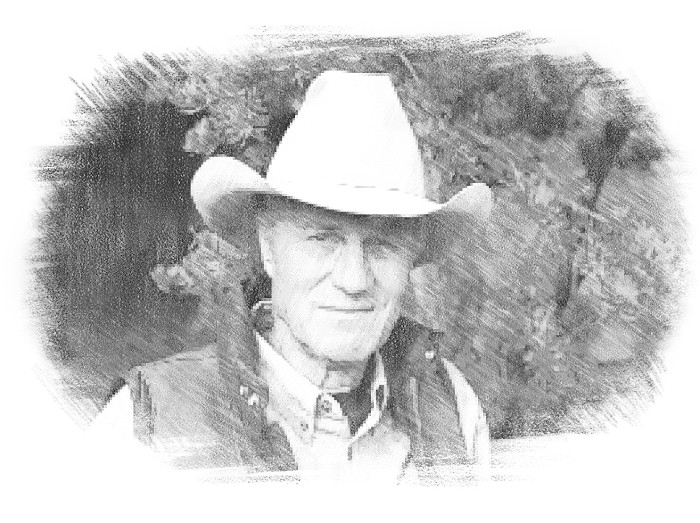
Gary Niblett, CA Emeritus
(b.1943)
Gary Niblett was born and raised in Carlsbad, New Mexico. After graduation, he went on to California, where he attended the Art Center School of Design. He spent eight years with the Hanna-Barbera studios as a background artist, but continued to develop his own style.
In 1973 Gary left commercial art to focus exclusively on Western art, and three years later was voted into the Cowboy Artists of America. He returned to New Mexico, where his work continued to gain national recognition.
His work has been exhibited all over the world, including the Grand Palais, France, and the Amerika Hass Berlin, Germany. He also has exhibited in Moscow, Taiwan, Beijing, and at the prestigious Royal Watercolor Society in London. Niblett’s work has been included in publications such as the International Fine Art Collector, Time, Saturday Review and New Mexico Magazine. In 1990, he was honored as the Distinguished Calendar Artist for New Mexico Magazine, and is featured in a book titled Gary Niblett – A New Look at the Old West.
He has been given the honor of having a large oil hanging in the state capitol building in Santa Fe, New Mexico.
Gary works mostly in oil, but says he is “comfortable in watercolor.” His art demands that we look into the reveries and still moments of the human spirit where the heart lives. His versatile work demonstrates the human values, which are brought to bear in living, not only in the American West, but in the world.
Source: Cowboy Artists of America
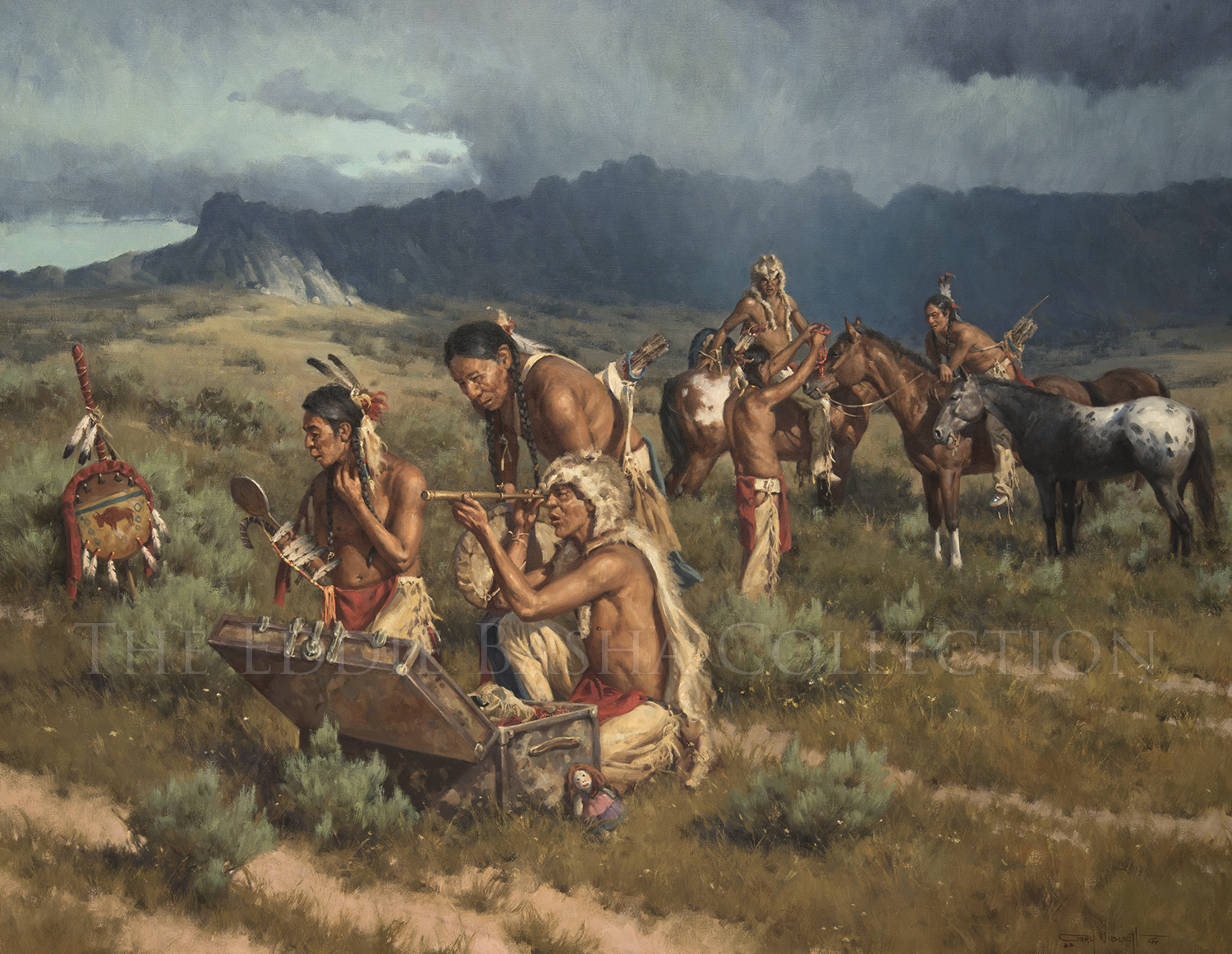
Spoils of the Trail
Artist: Gary Niblett, CA Emeritus (b.1943)
Description: Oil (2005) | Image Size: 45”h x 57 ½”w; Framed Size: 57 ½”h x 70”wpainting
In the final decades of the nineteenth century, waves of immigrants swept across the Great Plains and mountains of the West through land that had once been the exclusive domain of American Indian tribes. Conflicts were inevitable as these vastly different cultures came into contact with one another. Often the settlers were forced to leave prized possessions behind to facilitate their travels. In this masterwork, Gary Niblett shows a group of Plains warriors who have come across an abandoned trunk filled with objects that appear to be strange, wondrous, and perhaps not of much use to the Indians. A few of the warriors have dismounted and are looking at the items while the remainder of the party waits behind and on horseback. Some of these items will make their way back to the Indian camp, while others will be discarded and remain silent reminders of a hard journey. The Indians are shown in bright sunlight, but storm clouds are building on the horizon, their blue and grey colors provide an interesting contrast to the more muted tones of the sage covered prairie.
“Spoils of the Trail” made its debut at the 40th Annual Cowboy Artists of America Show & Sale in 2005 held in Phoenix, Arizona.
Trade Tobacco
Artist: Gary Niblett, CA Emeritus (b.1943)
Description: Watercolor (1996) | Image Size: 4 ½”h x 6 ½”w; Framed Size: 10”h x 12”wpainting
Following its debut at the 31st Annual Cowboy Artists Exhibition & Sale at the Phoenix Art Museum in
1996, Gary Niblett’s watercolor entitled “Trade Tobacco” has proudly been on exhibit at the EBC ever since. And don’t let its size fool anyone, it includes many references to the historical period it illustrates such as the subject’s clothing, weaponry, pipe and makeshift shelter. American Indians had used tobacco for ceremonial, cultural and trading practices long before the presence of Europeans on the continent.
The Ways of Old
Artist: Gary Niblett, CA Emeritus (b.1943)
Description: Water Soluble on Illustration Board (2005) | Image Size: 28”h x 34”w; Framed Size: 40”h x 46”wpainting
In most cultures, passing down knowledge and information from one generation to the next was the primary way of preserving a culture’s history and traditions. The skills that grandmothers and mothers taught their daughters and other family members ranged from making clothing to cooking to traditional crafts. More than just a way of teaching young people about their culture, often these skills were the keys to survival such as it was and remains in many communities.
In this painting, Cowboy Artist of America Gary Niblett shows just such a transfer of knowledge from one generation to the next. An older woman demonstrates her skills, while her younger student watches in rapt attention and attempts to duplicate the work. Judging by the clothing, these are members of a Plains Indian tribe, a nomadic culture that utilized many aspects of their natural surroundings in their daily lives. This piece made its debut at the 40th Annual CAA Show & Sale at the Phoenix Art Museum in 2005.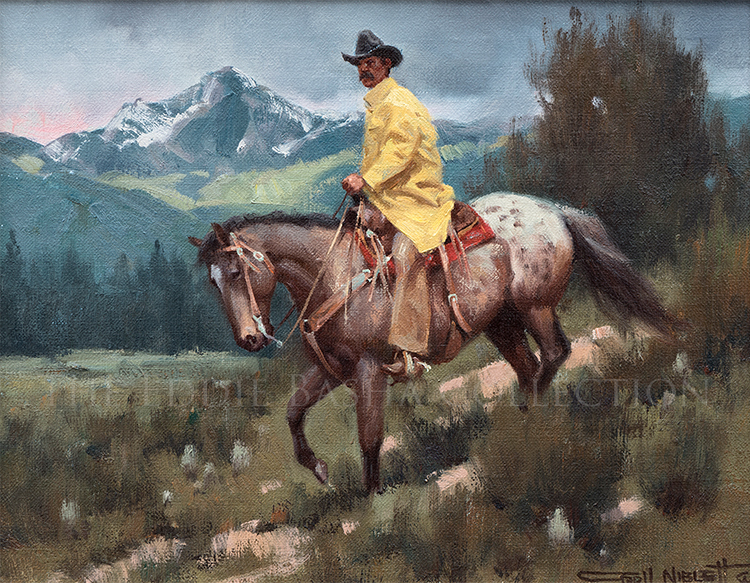
Down From the High Country
Artist: Gary Niblett, CA Emeritus (b.1943)
Description: Oil | Image Size: 11”h x 14”w; Framed Size: 16”h x 19”wpainting
This small painting of a cowboy making his way down into lower pastures from higher ground utilizes varying colors and textures to convey a realistic setting and activity. Niblett shows his cowboy wearing a bright yellow slicker which serves to focus the viewer’s attention on the center of the painting and also to highlight the bluish grey mountains in the distance. A small dab of pink on the horizon indicates the setting sun, signaling that this journey has most likely consumed most of the day. The colors are vivid with the horse and rider centered in the light of the descending sun.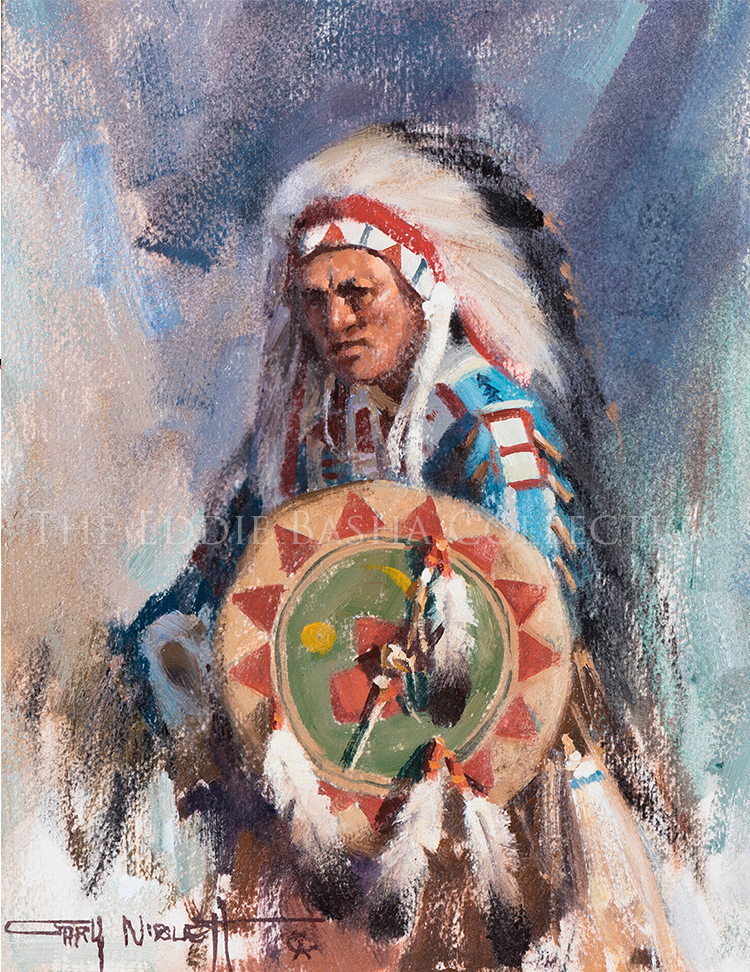
The War Shield
Artist: Gary Niblett, CA Emeritus (b.1943)
Description: Oil | Image Size: 11”h x 9”w; Framed Size: 17 ¾”h x 15 ¾”wpainting
Though a relatively small work and has the appearance of being an oil sketch, perhaps it was originally conceived as a model for a larger piece or merely a quick drawing. Even as a sketch, however, it shows Niblett’s attention to authentic detail. Much of the American Indian material he uses in his paintings can be found in his personal studio collection.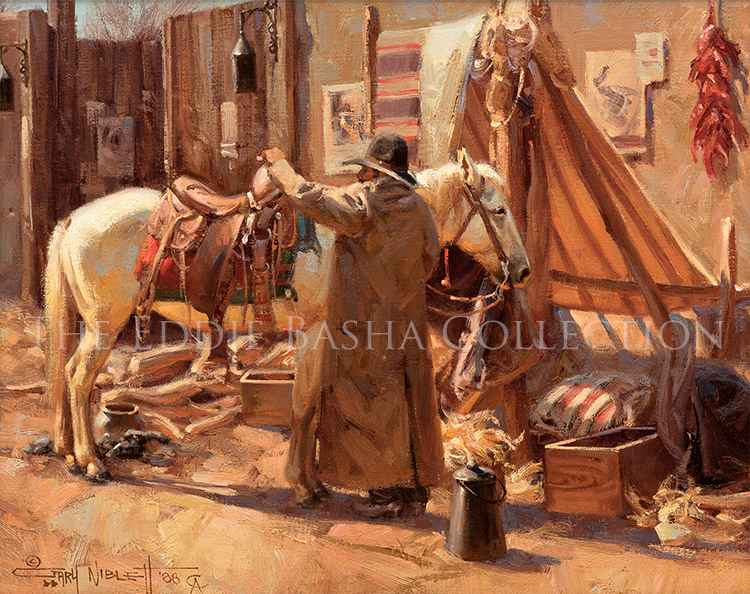
Border Town Stranger
Artist: Gary Niblett, CA Emeritus (b.1943)
Description: Oil (1988) | Image Size: 14”h x 18”w; Framed Size: 22”h x 25 ½”wpainting
This small painting is full of interesting period details of life in a small border town. The cowboy, who looks to have spent many days in the saddle, has stopped beside a makeshift market of sorts that has been set up against an adobe wall. Calendars and red peppers hang on the wall, while the area is littered with a variety of items ranging from a coffee pot to corn husks, pillows, blankets and tarps. The rider appears in a long duster and wide brimmed hat that have served him well in all kinds of weather over many miles. There is a sense of mystery about this loner who has made this noon day stop in a dusty village.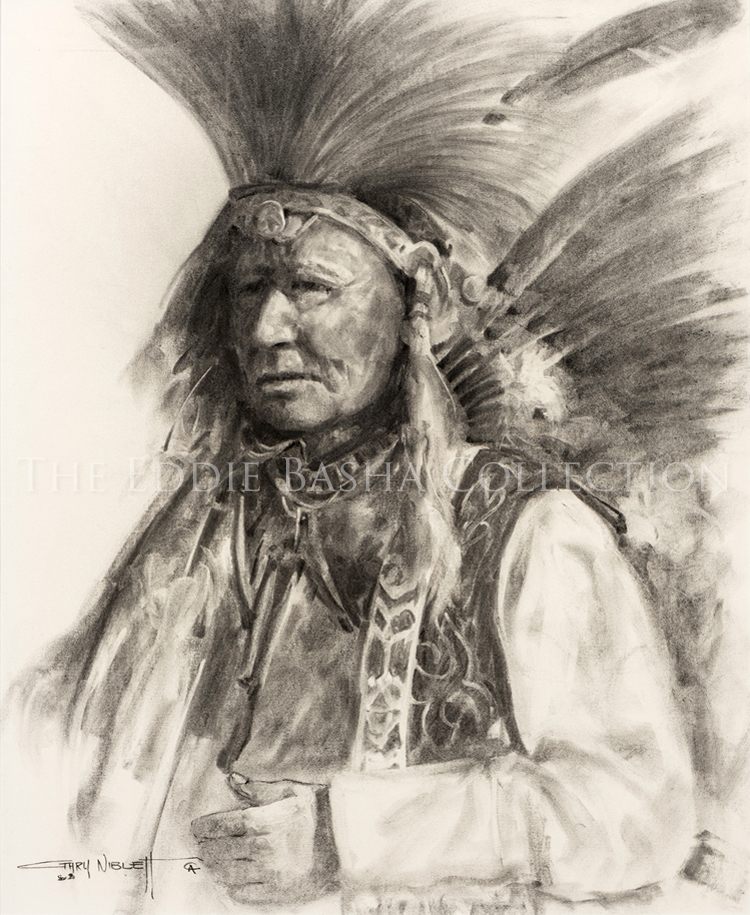
Taos War Dancer
Artist: Gary Niblett, CA Emeritus (b.1943)
Description: Charcoal | Image Size: 18”h x 15”w; Framed Size: 29”h x 25 ½”wdrawing
Living within close proximity to Taos Pueblo we’re pretty certain that Art Center College of Design graduate and Cowboy Artists of America Emeritus Member, Gary Niblett, has attended more than one of the annual pow wow events its hosted for the past thirty-two years.
“A pow wow is a gathering of Indian Nations in a common circle of friendship. Indian Country is made up of many tribal nations, bands, villages, and pueblos, each with their own traditional tribal beliefs and practices. A pow wow is the common fiber which draws Indian people together. It is a time for sharing with old friends and making new friends; a time for singing and dancing. It is also a time for trading — trading craft goods and trading songs.
Originally, Indian tribes held celebrations to commemorate successful hunts or harvests. Many tribes had ceremonial dances to prepare for war and to celebrate victories. The old tribal War Dance as it was known and is still called today, evolved over the last four or five decades into a contemporary social dance and the pow wow into a social gathering and celebration time.”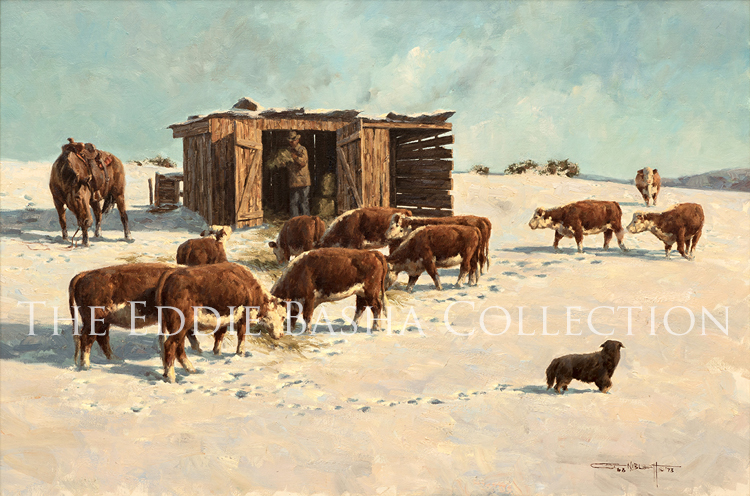
Winter Feeding
Artist: Gary Niblett, CA Emeritus (b.1943)
Description: Oil | Image Size: 24”h x 36”w; Framed Size: 31 ¾”h x 43 ¾”wpainting
Gary Niblett’s “Winter Feeding” conveys the stark realities of ranch work often consisting of difficult and routine chores that have to be performed regardless of the weather conditions. Here, Niblett shows a rancher working on a snow covered prairie tossing hay stored in a wood shed to protect it from the elements. The cows have gathered around for their daily feeding with a few stragglers still heading toward the shed. The rancher’s horse waits patiently while his dog keeps a wary eye out for predators. Without romanticizing the West, truly Niblett has provided the viewer with a realistic perspective of ranch life consisting of the obligatory and often mundane completion of chores.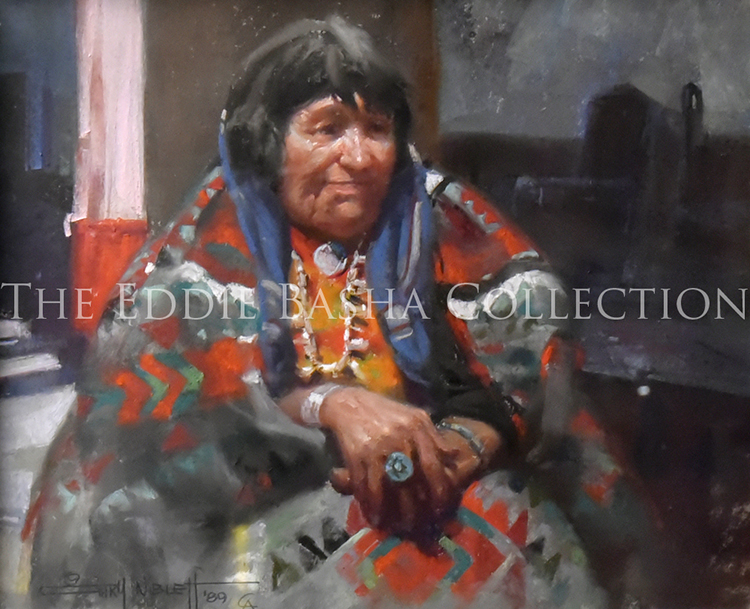
Santa Fe Vendor
Artist: Gary Niblett, CA Emeritus (b.1943)
Description: Water Soluble | Image Size: 12”h x 14”w; Framed Size: 25.25”h x 27.5”wpainting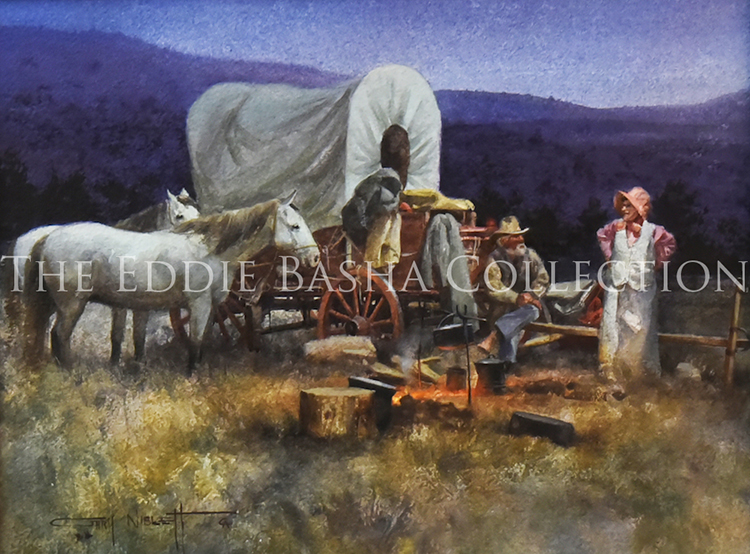
Enchanted Evening
Artist: Gary Niblett, CA Emeritus (b.1943)
Description: Watercolor | Image Size: 12”h x 16”w; Framed Size: 18 ½”h x 23”wpainting
It was daunting for pioneers and settlers making their way across open territory to start a new life far from family and friends. The journey was long, hard and fraught with danger, but wasn’t entirely without reward. Sometimes it was the comfort and mesmerizing glow of embers on a clear night or settling into the calm, the quiet and the peace that respite brings. Every reward was duly appreciated and never taken for granted.
Gary Niblett’s desire to express “still moments of the human spirit” is nurtured in “Enchanted Evening” with a stirring palette of cool, muted color that crafts the setting’s tone.
 Oil (2005) | Image Size: 45”h x 57 ½”w; Framed Size: 57 ½”h x 70”w
Oil (2005) | Image Size: 45”h x 57 ½”w; Framed Size: 57 ½”h x 70”wIn the final decades of the nineteenth century, waves of immigrants swept across the Great Plains and mountains of the West through land that had once been the exclusive domain of American Indian tribes. Conflicts were inevitable as these vastly different cultures came into contact with one another. Often the settlers were forced to leave prized possessions behind to facilitate their travels. In this masterwork, Gary Niblett shows a group of Plains warriors who have come across an abandoned trunk filled with objects that appear to be strange, wondrous, and perhaps not of much use to the Indians. A few of the warriors have dismounted and are looking at the items while the remainder of the party waits behind and on horseback. Some of these items will make their way back to the Indian camp, while others will be discarded and remain silent reminders of a hard journey. The Indians are shown in bright sunlight, but storm clouds are building on the horizon, their blue and grey colors provide an interesting contrast to the more muted tones of the sage covered prairie.
“Spoils of the Trail” made its debut at the 40th Annual Cowboy Artists of America Show & Sale in 2005 held in Phoenix, Arizona.
Spoils of the Trail
Artist: Gary Niblett, CA Emeritus (b.1943)
In the final decades of the nineteenth century, waves of immigrants swept across the Great Plains and mountains of the West through land that had once been the exclusive domain of American Indian tribes. Conflicts were inevitable as these vastly different cultures came into contact with one another. Often the settlers were forced to leave prized possessions behind to facilitate their travels. In this masterwork, Gary Niblett shows a group of Plains warriors who have come across an abandoned trunk filled with objects that appear to be strange, wondrous, and perhaps not of much use to the Indians. A few of the warriors have dismounted and are looking at the items while the remainder of the party waits behind and on horseback. Some of these items will make their way back to the Indian camp, while others will be discarded and remain silent reminders of a hard journey. The Indians are shown in bright sunlight, but storm clouds are building on the horizon, their blue and grey colors provide an interesting contrast to the more muted tones of the sage covered prairie.
“Spoils of the Trail” made its debut at the 40th Annual Cowboy Artists of America Show & Sale in 2005 held in Phoenix, Arizona.
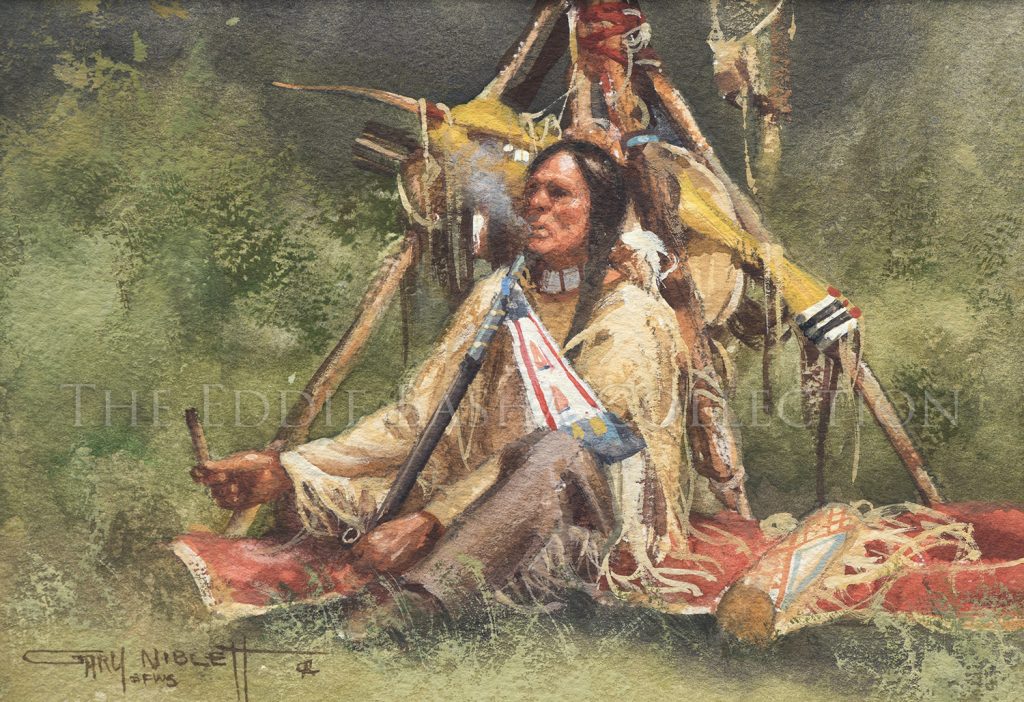 Watercolor (1996) | Image Size: 4 ½”h x 6 ½”w; Framed Size: 10”h x 12”w
Watercolor (1996) | Image Size: 4 ½”h x 6 ½”w; Framed Size: 10”h x 12”wFollowing its debut at the 31st Annual Cowboy Artists Exhibition & Sale at the Phoenix Art Museum in
1996, Gary Niblett’s watercolor entitled “Trade Tobacco” has proudly been on exhibit at the EBC ever since. And don’t let its size fool anyone, it includes many references to the historical period it illustrates such as the subject’s clothing, weaponry, pipe and makeshift shelter. American Indians had used tobacco for ceremonial, cultural and trading practices long before the presence of Europeans on the continent.
Trade Tobacco
Artist: Gary Niblett, CA Emeritus (b.1943)
Following its debut at the 31st Annual Cowboy Artists Exhibition & Sale at the Phoenix Art Museum in
1996, Gary Niblett’s watercolor entitled “Trade Tobacco” has proudly been on exhibit at the EBC ever since. And don’t let its size fool anyone, it includes many references to the historical period it illustrates such as the subject’s clothing, weaponry, pipe and makeshift shelter. American Indians had used tobacco for ceremonial, cultural and trading practices long before the presence of Europeans on the continent.
 Water Soluble on Illustration Board (2005) | Image Size: 28”h x 34”w; Framed Size: 40”h x 46”w
Water Soluble on Illustration Board (2005) | Image Size: 28”h x 34”w; Framed Size: 40”h x 46”wIn most cultures, passing down knowledge and information from one generation to the next was the primary way of preserving a culture’s history and traditions. The skills that grandmothers and mothers taught their daughters and other family members ranged from making clothing to cooking to traditional crafts. More than just a way of teaching young people about their culture, often these skills were the keys to survival such as it was and remains in many communities.
In this painting, Cowboy Artist of America Gary Niblett shows just such a transfer of knowledge from one generation to the next. An older woman demonstrates her skills, while her younger student watches in rapt attention and attempts to duplicate the work. Judging by the clothing, these are members of a Plains Indian tribe, a nomadic culture that utilized many aspects of their natural surroundings in their daily lives. This piece made its debut at the 40th Annual CAA Show & Sale at the Phoenix Art Museum in 2005.
The Ways of Old
Artist: Gary Niblett, CA Emeritus (b.1943)
In most cultures, passing down knowledge and information from one generation to the next was the primary way of preserving a culture’s history and traditions. The skills that grandmothers and mothers taught their daughters and other family members ranged from making clothing to cooking to traditional crafts. More than just a way of teaching young people about their culture, often these skills were the keys to survival such as it was and remains in many communities.
In this painting, Cowboy Artist of America Gary Niblett shows just such a transfer of knowledge from one generation to the next. An older woman demonstrates her skills, while her younger student watches in rapt attention and attempts to duplicate the work. Judging by the clothing, these are members of a Plains Indian tribe, a nomadic culture that utilized many aspects of their natural surroundings in their daily lives. This piece made its debut at the 40th Annual CAA Show & Sale at the Phoenix Art Museum in 2005.
 Oil | Image Size: 11”h x 14”w; Framed Size: 16”h x 19”w
Oil | Image Size: 11”h x 14”w; Framed Size: 16”h x 19”wThis small painting of a cowboy making his way down into lower pastures from higher ground utilizes varying colors and textures to convey a realistic setting and activity. Niblett shows his cowboy wearing a bright yellow slicker which serves to focus the viewer’s attention on the center of the painting and also to highlight the bluish grey mountains in the distance. A small dab of pink on the horizon indicates the setting sun, signaling that this journey has most likely consumed most of the day. The colors are vivid with the horse and rider centered in the light of the descending sun.
Down From the High Country
Artist: Gary Niblett, CA Emeritus (b.1943)
This small painting of a cowboy making his way down into lower pastures from higher ground utilizes varying colors and textures to convey a realistic setting and activity. Niblett shows his cowboy wearing a bright yellow slicker which serves to focus the viewer’s attention on the center of the painting and also to highlight the bluish grey mountains in the distance. A small dab of pink on the horizon indicates the setting sun, signaling that this journey has most likely consumed most of the day. The colors are vivid with the horse and rider centered in the light of the descending sun.
 Oil | Image Size: 11”h x 9”w; Framed Size: 17 ¾”h x 15 ¾”w
Oil | Image Size: 11”h x 9”w; Framed Size: 17 ¾”h x 15 ¾”wThough a relatively small work and has the appearance of being an oil sketch, perhaps it was originally conceived as a model for a larger piece or merely a quick drawing. Even as a sketch, however, it shows Niblett’s attention to authentic detail. Much of the American Indian material he uses in his paintings can be found in his personal studio collection.
The War Shield
Artist: Gary Niblett, CA Emeritus (b.1943)
Though a relatively small work and has the appearance of being an oil sketch, perhaps it was originally conceived as a model for a larger piece or merely a quick drawing. Even as a sketch, however, it shows Niblett’s attention to authentic detail. Much of the American Indian material he uses in his paintings can be found in his personal studio collection.
 Oil (1988) | Image Size: 14”h x 18”w; Framed Size: 22”h x 25 ½”w
Oil (1988) | Image Size: 14”h x 18”w; Framed Size: 22”h x 25 ½”wThis small painting is full of interesting period details of life in a small border town. The cowboy, who looks to have spent many days in the saddle, has stopped beside a makeshift market of sorts that has been set up against an adobe wall. Calendars and red peppers hang on the wall, while the area is littered with a variety of items ranging from a coffee pot to corn husks, pillows, blankets and tarps. The rider appears in a long duster and wide brimmed hat that have served him well in all kinds of weather over many miles. There is a sense of mystery about this loner who has made this noon day stop in a dusty village.
Border Town Stranger
Artist: Gary Niblett, CA Emeritus (b.1943)
This small painting is full of interesting period details of life in a small border town. The cowboy, who looks to have spent many days in the saddle, has stopped beside a makeshift market of sorts that has been set up against an adobe wall. Calendars and red peppers hang on the wall, while the area is littered with a variety of items ranging from a coffee pot to corn husks, pillows, blankets and tarps. The rider appears in a long duster and wide brimmed hat that have served him well in all kinds of weather over many miles. There is a sense of mystery about this loner who has made this noon day stop in a dusty village.
 Charcoal | Image Size: 18”h x 15”w; Framed Size: 29”h x 25 ½”w
Charcoal | Image Size: 18”h x 15”w; Framed Size: 29”h x 25 ½”wLiving within close proximity to Taos Pueblo we’re pretty certain that Art Center College of Design graduate and Cowboy Artists of America Emeritus Member, Gary Niblett, has attended more than one of the annual pow wow events its hosted for the past thirty-two years.
“A pow wow is a gathering of Indian Nations in a common circle of friendship. Indian Country is made up of many tribal nations, bands, villages, and pueblos, each with their own traditional tribal beliefs and practices. A pow wow is the common fiber which draws Indian people together. It is a time for sharing with old friends and making new friends; a time for singing and dancing. It is also a time for trading — trading craft goods and trading songs.
Originally, Indian tribes held celebrations to commemorate successful hunts or harvests. Many tribes had ceremonial dances to prepare for war and to celebrate victories. The old tribal War Dance as it was known and is still called today, evolved over the last four or five decades into a contemporary social dance and the pow wow into a social gathering and celebration time.”
Taos War Dancer
Artist: Gary Niblett, CA Emeritus (b.1943)
Living within close proximity to Taos Pueblo we’re pretty certain that Art Center College of Design graduate and Cowboy Artists of America Emeritus Member, Gary Niblett, has attended more than one of the annual pow wow events its hosted for the past thirty-two years.
“A pow wow is a gathering of Indian Nations in a common circle of friendship. Indian Country is made up of many tribal nations, bands, villages, and pueblos, each with their own traditional tribal beliefs and practices. A pow wow is the common fiber which draws Indian people together. It is a time for sharing with old friends and making new friends; a time for singing and dancing. It is also a time for trading — trading craft goods and trading songs.
Originally, Indian tribes held celebrations to commemorate successful hunts or harvests. Many tribes had ceremonial dances to prepare for war and to celebrate victories. The old tribal War Dance as it was known and is still called today, evolved over the last four or five decades into a contemporary social dance and the pow wow into a social gathering and celebration time.”
 Oil | Image Size: 24”h x 36”w; Framed Size: 31 ¾”h x 43 ¾”w
Oil | Image Size: 24”h x 36”w; Framed Size: 31 ¾”h x 43 ¾”wGary Niblett’s “Winter Feeding” conveys the stark realities of ranch work often consisting of difficult and routine chores that have to be performed regardless of the weather conditions. Here, Niblett shows a rancher working on a snow covered prairie tossing hay stored in a wood shed to protect it from the elements. The cows have gathered around for their daily feeding with a few stragglers still heading toward the shed. The rancher’s horse waits patiently while his dog keeps a wary eye out for predators. Without romanticizing the West, truly Niblett has provided the viewer with a realistic perspective of ranch life consisting of the obligatory and often mundane completion of chores.
Winter Feeding
Artist: Gary Niblett, CA Emeritus (b.1943)
Gary Niblett’s “Winter Feeding” conveys the stark realities of ranch work often consisting of difficult and routine chores that have to be performed regardless of the weather conditions. Here, Niblett shows a rancher working on a snow covered prairie tossing hay stored in a wood shed to protect it from the elements. The cows have gathered around for their daily feeding with a few stragglers still heading toward the shed. The rancher’s horse waits patiently while his dog keeps a wary eye out for predators. Without romanticizing the West, truly Niblett has provided the viewer with a realistic perspective of ranch life consisting of the obligatory and often mundane completion of chores.
 Water Soluble | Image Size: 12”h x 14”w; Framed Size: 25.25”h x 27.5”w
Water Soluble | Image Size: 12”h x 14”w; Framed Size: 25.25”h x 27.5”wSanta Fe Vendor
Artist: Gary Niblett, CA Emeritus (b.1943)
 Watercolor | Image Size: 12”h x 16”w; Framed Size: 18 ½”h x 23”w
Watercolor | Image Size: 12”h x 16”w; Framed Size: 18 ½”h x 23”w It was daunting for pioneers and settlers making their way across open territory to start a new life far from family and friends. The journey was long, hard and fraught with danger, but wasn’t entirely without reward. Sometimes it was the comfort and mesmerizing glow of embers on a clear night or settling into the calm, the quiet and the peace that respite brings. Every reward was duly appreciated and never taken for granted.
Gary Niblett’s desire to express “still moments of the human spirit” is nurtured in “Enchanted Evening” with a stirring palette of cool, muted color that crafts the setting’s tone.
Enchanted Evening
Artist: Gary Niblett, CA Emeritus (b.1943)
It was daunting for pioneers and settlers making their way across open territory to start a new life far from family and friends. The journey was long, hard and fraught with danger, but wasn’t entirely without reward. Sometimes it was the comfort and mesmerizing glow of embers on a clear night or settling into the calm, the quiet and the peace that respite brings. Every reward was duly appreciated and never taken for granted.
Gary Niblett’s desire to express “still moments of the human spirit” is nurtured in “Enchanted Evening” with a stirring palette of cool, muted color that crafts the setting’s tone.